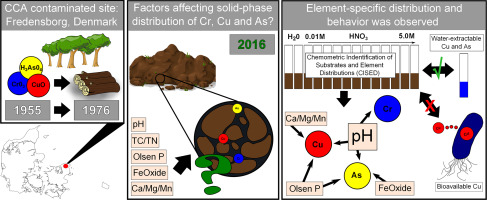Science of the Total Environment ( IF 8.2 ) Pub Date : 2018-10-18 , DOI: 10.1016/j.scitotenv.2018.10.244 Stacie Tardif , Sabrina Cipullo , Helle U. Sø , Joanna Wragg , Peter E. Holm , Frederic Coulon , Kristian K. Brandt , Mark Cave

|
The physico-chemical factors affecting the distribution, behavior and speciation of chromium (Cr), copper (Cu) and arsenic (As) was investigated at a former wood impregnation site (Fredensborg, Denmark). Forty soil samples were collected and extracted using a sequential extraction technique known as the Chemometric Identification of Substrates and Element Distributions (CISED) and a multivariate statistical tool (redundancy analysis) was applied. CISED data was linked to water-extractable Cr, Cu and As and bioavailable Cu as determined by a whole-cell bacterial bioreporter assay. Results showed that soil pH significantly affected the solid phase distribution of all three elements on site. Additionally, elements competing for binding sites, Ca, Mg and Mn in the case of Cu, and P, in the case of As, played a major role in the distribution of these elements in soil. Element-specific distributions were observed amongst the six identified soil phases including residual pore salts, exchangeable, carbonates (tentative designation), Mn-Al oxide, amorphous Fe oxide, and crystalline Fe oxide. While Cr was strongly bound to non-extractable crystalline Fe oxide in the oxic top soil, Cu and notably, As were associated with readily extractable phases, suggesting that Cu and As, and not Cr, constitute the highest risk to environmental and human health. However, bioavailable Cu did not significantly correlate with CISED identified soil phases, suggesting that sequential extraction schemes such as CISED may not be ideally suited for inferring bioavailability to microorganisms in soil and supports the integration of receptor-specific bioavailability tests into risk assessments as a complement to chemical methods.
中文翻译:

老化40年后受污染土壤中Cr,Cu和As固相分布的控制因素
在以前的木材浸渍场所(丹麦弗雷登斯堡)研究了影响铬(Cr),铜(Cu)和砷(As)的分布,行为和形态的物理化学因素。使用称为基质和元素分布的化学计量鉴定(CISED)的顺序提取技术收集并提取了40个土壤样品,并使用了多元统计工具(冗余分析)。CISED数据与水提取性Cr,Cu和As以及通过全细胞细菌生物报告试剂测定法确定的生物利用度Cu相关联。结果表明,土壤pH值会显着影响现场所有这三种元素的固相分布。另外,竞争结合位点的元素是钙,镁和锰,如果是铜,则是磷,如果是砷,这些元素在土壤中的分布起着重要作用。在六个确定的土壤相中观察到了元素特定的分布,包括残留的孔隙盐,可交换的碳酸盐,碳酸盐(暂定名称),Mn-Al氧化物,非晶态的Fe氧化物和结晶的Fe氧化物。Cr在有氧表层土壤中与不可提取的结晶Fe氧化物牢固结合,而Cu尤其是Cu与易于提取的相相关,这表明Cu和As而不是Cr对环境和人类健康构成最高风险。但是,可利用的铜与CISED确定的土壤相没有显着相关,











































 京公网安备 11010802027423号
京公网安备 11010802027423号